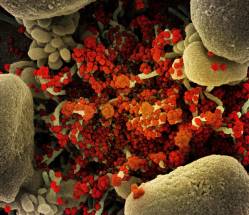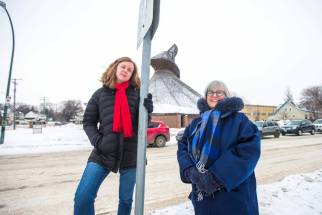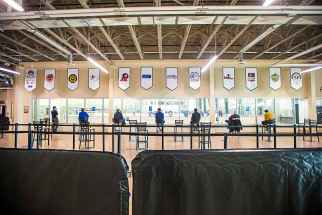No winners in Omicron roulette
Read this article for free:
or
Already have an account? Log in here »
To continue reading, please subscribe:
Monthly Digital Subscription
$0 for the first 4 weeks*
- Enjoy unlimited reading on winnipegfreepress.com
- Read the E-Edition, our digital replica newspaper
- Access News Break, our award-winning app
- Play interactive puzzles
*No charge for 4 weeks then price increases to the regular rate of $19.00 plus GST every four weeks. Offer available to new and qualified returning subscribers only. Cancel any time.
Monthly Digital Subscription
$4.75/week*
- Enjoy unlimited reading on winnipegfreepress.com
- Read the E-Edition, our digital replica newspaper
- Access News Break, our award-winning app
- Play interactive puzzles
*Billed as $19 plus GST every four weeks. Cancel any time.
To continue reading, please subscribe:
Add Free Press access to your Brandon Sun subscription for only an additional
$1 for the first 4 weeks*
*Your next subscription payment will increase by $1.00 and you will be charged $16.99 plus GST for four weeks. After four weeks, your payment will increase to $23.99 plus GST every four weeks.
Read unlimited articles for free today:
or
Already have an account? Log in here »
Hey there, time traveller!
This article was published 03/01/2022 (1434 days ago), so information in it may no longer be current.
Welcome to Omicron roulette.
Faced with clear-and-present COVID-19 danger, the Manitoba government continues to spin the cylinder on the pandemic gun, pointing it at the population and hoping each time it pulls the trigger, the chamber will be empty.
More specifically, Manitoba continues to use minimal restrictions to combat the most recent wave of COVID-19.
Residents are still largely able to do what they were doing before the current wave struck: eat in restaurants and bars; attend sporting events, live music and movies; socialize in each other’s homes; attend fitness centres; engage in recreational activities and in-person religious services.

The calculus is simple: given Omicron produces milder symptoms, the Progressive Conservative government is allowing the surging novel coronavirus variant to run its course in the hope it will not kill a lot of people or overwhelm the health-care system.
This theory is not completely baseless.
Emerging science on Omicron suggests it packs much less of a wallop than previous variants, meaning a smaller percentage of overall new cases require hospitalization. Even though it seems able to infect fully vaccinated people at will, most of those people suffer little or no symptoms.
For many of those who are exhausted from pandemic restrictions, this optimistic view of Omicron suggests the pandemic is entering a stage where the virus and the disease it causes are becoming less of a threat.
Not everyone shares that optimism.
Many medical and scientific experts outside government continue to plead with political leaders to restrict activities that pose the greatest risk of transmission. Given Omicron’s less severe outcomes and Manitoba’s generally high vaccination rates, it’s a position many find frustrating and confusing.
If Omicron poses less individual risk, why should officials apply the same restrictions used to contain more deadly variants?

As is the case in any game of Russian roulette, even though you start out with a greater statistical chance of survival, the risk is always there. In this case, that persistent risk is the fact Omicron is exponentially more infectious than other variants.
On Monday, Ontario Premier Doug Ford announced, as of Jan. 5, public schools will be closed to in-person learning for two weeks, while gyms and restaurants will be shuttered for 21 days. Ford said the measures were needed to “ease the pressure on our hospitals.”
“The evidence tells us that about one per cent of people who get Omicron will end up in hospital,” the PC premier said. “One per cent of hundreds of thousands (of infections) is too many new patients.”
Ford’s statement should be required reading for every premier in this country. Given provinces such as Ontario and Quebec (which has also introduced new, severe restrictions) have higher population density in major cities and are hubs for international travel, they also function as a preview of coming pandemic attractions.

After several weeks of rising case counts, Quebec and Ontario have had hospitalizations and ICU admissions start to climb significantly.
Over the weekend, Dr. Anthony Fauci, the U.S. government’s top infectious disease expert, said world leaders need to stop using the sheer number of new infections to assess the severity of the current outbreak. The total number of hospitalizations, he noted, will be a much better metric going forward and there is no doubt Omicron will, eventually, fill hospitals.
Applying Fauci’s logic to Manitoba’s current situation, there is reason to be alarmed. Not about what’s happening now, but what the province will face in a few weeks’ time.
Manitoba (due to location and population) has always enjoyed the benefit of being among the last places to get swallowed up by a new wave of COVID-19. In theory, that gives it a head start to confront impending surges before they overwhelm the heath-care system.
That’s the theory.
Unfortunately, Tory Premier Heather Stefanson seems content to follow the same ill-fated strategy employed by her predecessor Brian Pallister: ratchet up restrictions incrementally as conditions worsen; avoid short, sharp “circuit-breaker” lockdowns that experts outside government advocate.
Stefanson needs to read the writing on the pandemic wall. Even though it lags behind Ontario and Quebec, more than 5,400 new infections were registered over the past three days in Manitoba.
More importantly, hospitalizations and ICU admissions — while lower than last spring’s deadly third wave — are creeping steadily upward.
If officials hold back on more severe restrictions now, Manitoba will most certainly see a worsening situation. It’s already happening in other places.
Omicron roulette may seem like a good strategy to a political leader tired of justifying pandemic restrictions to a populace increasingly weary of being told what they cannot do.
But in the end, these leaders must realize there is only one certainty: the longer you play, the less chance there will be any winners.
dan.lett@freepress.mb.ca

Born and raised in and around Toronto, Dan Lett came to Winnipeg in 1986, less than a year out of journalism school with a lifelong dream to be a newspaper reporter.
Our newsroom depends on a growing audience of readers to power our journalism. If you are not a paid reader, please consider becoming a subscriber.
Our newsroom depends on its audience of readers to power our journalism. Thank you for your support.
History
Updated on Tuesday, January 4, 2022 9:10 AM CST: Corrects typo






